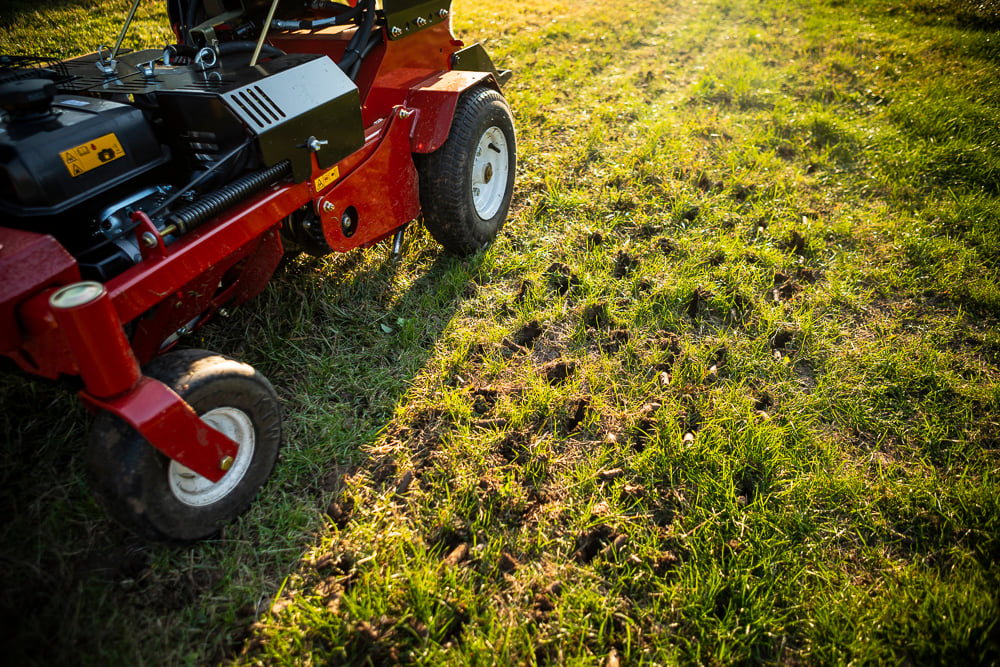Quick quiz: How thick is your lawn thatch?
You: …
Lawn thatch might not come up in your daily conversation, but it could be lurking beneath your lawn, growing thicker and spongier, and causing your lawn to struggle for air and water.
What is lawn thatch? Is it bad for your lawn?
Jump to Section:
- What Is Lawn Thatch?
- Is Thatch Bad for Lawns?
- What Are Microbes and How Do They Help Reduce Thatch?
- How Do You Remove Thatch Without Damaging the Grass?
- As Long As Your Lawn Is Full of Holes…
- When Is the Best Time to Tackle Lawn Thatch with Aeration?
- Aeration Does More Than Remove Thatch
- Should You Bag Grass Clippings to Reduce Thatch?
- Other Ways to Attack Lawn Thatch
- Should You DIY Lawn Thatch Removal?
- How to Prevent Lawn Thatch
- Avoid Lawn Thatch Damage with RainMaster
Lawn thatch is a layer of partially decomposed plant material and shallow roots that form a dense mat just beneath your lawn.
A small amount of thatch benefits your lawn; however, when grass thatch accumulates over time and becomes excessively thick, it obstructs water, oxygen, and fertilizer from reaching the roots. As a result, your lawn may struggle and weaken.
Keep reading to learn more about lawn thatch causes and what to do about it, including:
What Is Lawn Thatch?
Lawn thatch is a layer of partially decomposed plant material and shallow roots that form a dense mat just beneath your lawn.
Thatch forms naturally over time as your grass grows and dies.

Typically, it breaks down on its own over time, but sometimes it builds up and gets thicker. That’s when you need to take action to prevent lawn thatch damage.
Is Thatch Bad for Lawns?
A little bit of thatch is good for your lawn. A thin layer, less than half an inch or so, is doing some good out there.
How?
It shades the soil to keep it cool. It helps your lawn retain moisture, much like a sponge. It acts as a bit of a cushion for foot traffic.
However, when grass thatch builds up and becomes thicker, things become more complicated.
When thatch gets too thick, oxygen, water and fertilizer can’t reach your lawn’s roots, which means your lawn struggles and gets weak.
A thick layer of lawn thatch absorbs and retains a significant amount of water. This can encourage fungus. And when this water builds up, it keeps air from getting to your lawn’s roots, suffocating your lawn.
It gets worse. A thick layer of lawn thatch can attract damaging insects. It’s dark, damp, and there are roots to munch. It’s a cozy bug resort. Thick thatch also encourages lawn diseases.
You might be encouraging thatch without even realizing it. While lawn thatch forms naturally, overwatering encourages it. Too much water prevents thatch from breaking down, allowing it to build up and become thicker.
Your goal should be to add an inch of water per week, including any rain that falls.
What Are Microbes and How Do They Help Reduce Lawn Thatch?
When’s the last time your neighbor called over the fence, “Hey, how are your soil microbes doing?” Chances are, never. But they’re a crucial part of what’s going on out there.
You want a lawn rich with microbes, tiny creatures that help control lawn thatch.
Microbes are tiny living organisms, including bacteria and fungi, that naturally decompose organic matter.

These microscopic microbes break down organic matter, such as dead grass and fallen leaves, and release nutrients that your grass can utilize.
Lots of microbes in your soil? That’s a good thing.
When your lawn is low on microbes, decomposition slows down, and thatch begins to build up faster than it can break down. That’s when you risk lawn thatch damage.
More on how you can add microbes as part of your Minneapolis lawn care in a bit.
How Do You Remove Thatch Without Damaging the Grass?
Is there an easy way to remove lawn thatch? Lawn aeration is your best bet.
Aeration uses a machine to pull out tiny cores of soil from your lawn.
When lawn aeration removes plugs from the thatch, it loosens it up and helps it decompose, allowing oxygen, nutrients, and moisture to reach the roots.
As Long As Your Lawn Is Full of Holes...
When Minneapolis lawn care experts discuss aeration, they almost always pair it with overseeding.

As long as your lawn is filled with holes from the aerator, it’s the perfect time to add grass seed to help rejuvenate your lawn.
Aeration and overseeding can work wonders on a lawn that needs a boost.
When Is the Best Time to Tackle Lawn Thatch with Aeration?
Here in Minneapolis, fall is the ideal time to reduce thatch in your lawn with lawn aeration, especially if you plan to pair it with seeding.
Why fall? A few good reasons:
The weather is nice and cool here in the fall, which is perfect for that new grass seed to germinate and grow.
Fall can be rainy, which means free watering from Mother Nature.
Fewer weed seeds are blowing around in the fall, which can settle into the aeration holes and grow. Why give weeds an advantage, right?
There’s less mowing and foot traffic in the fall, making it easier for new grass to thrive.
Aeration Does More Than Remove Lawn Thatch
Yes, aeration does a great job of helping excess thatch break down, but it offers plenty of benefits beyond that:
When your soil is looser and airier, your fertilizer can easily make its way down to your lawn’s roots and get to work boosting your lawn’s health.

Aeration helps water soak into your lawn more efficiently.
If you incorporate aeration into a comprehensive lawn care program, you can expect to see a reduction in weeds.
Other Ways to Attack Grass Thatch
Here at RainMaster, aeration is our preferred method for removing thatch, but other tools are available, too:
Thatch Rake
Specialized thatch rakes have tines designed to lift and remove thatch from the lawn surface.
Power Rake
Power rakes, also known as mechanical dethatchers, feature vertical blades that cut into the thatch, making it easier to remove.
Should You DIY Lawn Thatch Removal?
If you choose aeration as your thatch-removing strategy, you might consider renting an aerator.
We know what you’re thinking - it’ll probably save you some money, right? The amount you save might not be worth the hassle.
Depending on the size of your lawn, the difference may not be significant.
Plus, this chore is hard work.

These 300-lb. lawn aerator beasts are bulky and heavy. And they don’t exactly glide effortlessly across your lawn. They really rattle your bones.
Is it really how you want to spend a sunny Saturday?
If your thatch is thick and your soil is compacted, your rental aerator might not even penetrate the compacted soil. Alternatively, you may need to make two passes with the aerator, which is twice the work and time.
Professionals use more powerful stand-on aerators that utilize hydraulic pressure to drive the tines into the ground and extract deep cores of soil.
How to Prevent Lawn Thatch In the First Place
Some strategies help prevent too much thatch from accumulating:
Mowing might not be your favorite chore, but don’t procrastinate. Mow frequently, removing only 1/3 of the grass blade at a time. This helps prevent the accumulation of large clippings that can contribute to grass thatch.
Water less often but deeply to encourage deep root growth and healthy grass, which helps break down lawn thatch naturally. Avoid shallow, frequent watering.

Don’t fertilize too often. Too much nitrogen causes grass to grow fast, producing more organic matter than those hard-working microbes can decompose. The first round of fertilizer and weed control should be done by Memorial Day. Three more applications are expected to occur throughout the summer.
Aerate your lawn annually, especially if your soil is compacted or clay. Aeration helps air, water, and fertilizer reach your lawn’s roots, which enables your healthy lawn to break down thatch naturally.
Add a topdressing of compost to your lawn, which can help break down lawn thatch and improve your soil health. Remember those tiny, helpful microbes we discussed earlier? Compost adds them.
Should You Bag Grass Clippings to Reduce Thatch?
This sounds like it might be helpful, but the answer is no. Bagging your grass clippings doesn’t significantly reduce lawn thatch.
Leaving your grass clippings on the lawn is beneficial.
Grass clippings contain the same beneficial nutrients, including nitrogen, phosphorus, and potassium, as fertilizer. As those clippings break down and decompose, they add valuable nutrients to the soil, helping to nourish your lawn.
And those clippings can help break down thatch by providing food for the handy microbes that decompose organic matter.
Avoid Lawn Thatch Damage with RainMaster
Now you know about microbes and lawn clippings and not to fertilize too often, but it might all boil down to one pressing question:
Is there an easy way to remove lawn thatch?
You bet. Give us a call. Aeration is a great solution.
But it’s just part of comprehensive lawn care in Minneapolis, MN.

Invest in a comprehensive, proactive lawn care program to continuously improve and protect your lawn, ensuring the roots are nourished, the soil is packed with nutrients, and your grass is thick and healthy.
Choose from three different levels of lawn care programs, based on the results you’d like, how fast you want to see results, and your budget.
You deserve great customer experiences, competent professionals on your lawn, and high-end products that deliver results.
Let’s get to the bottom of your lawn problems. Request a quote today! We’ll review your lawn care options together so you can make a great choice. Then, you can finally enjoy your lawn and stop worrying about it.




